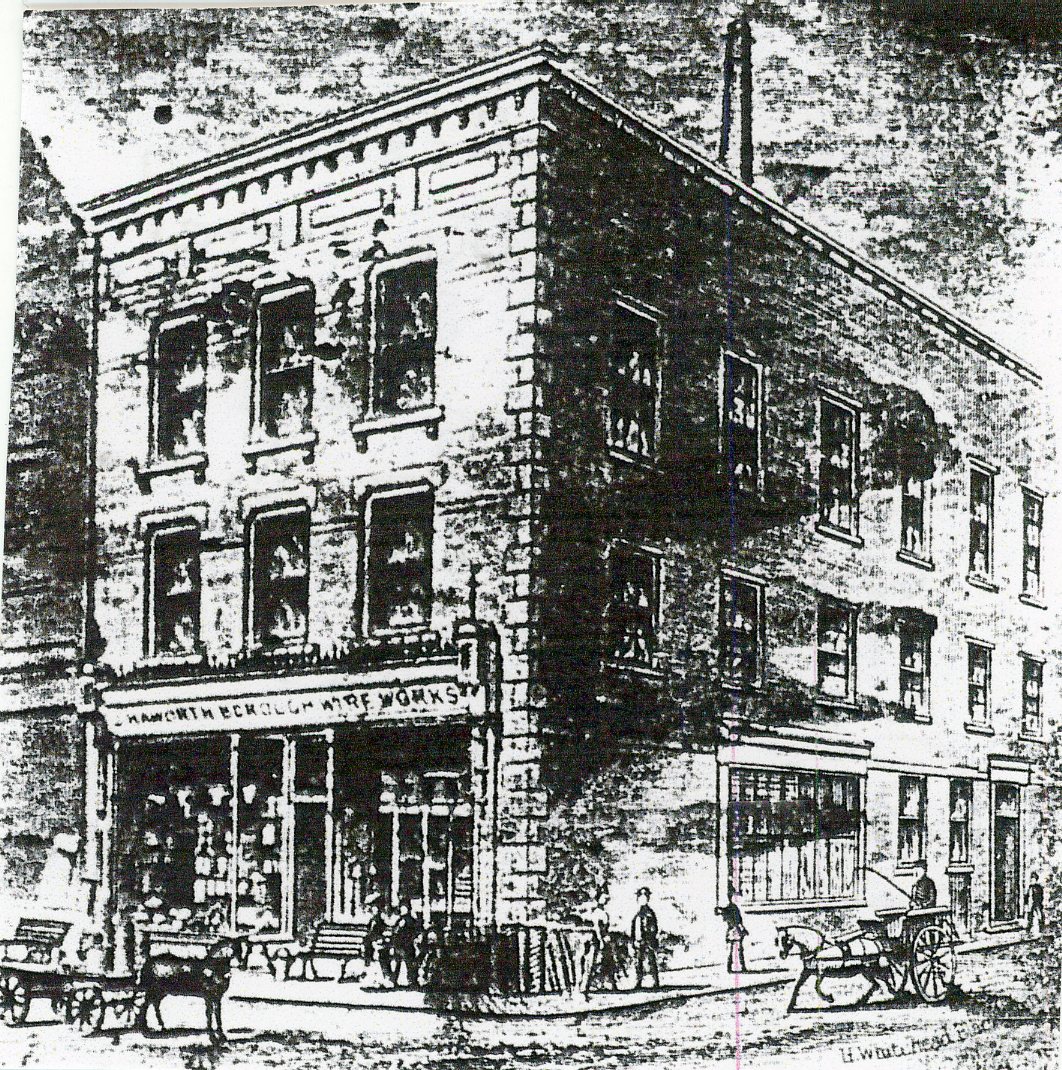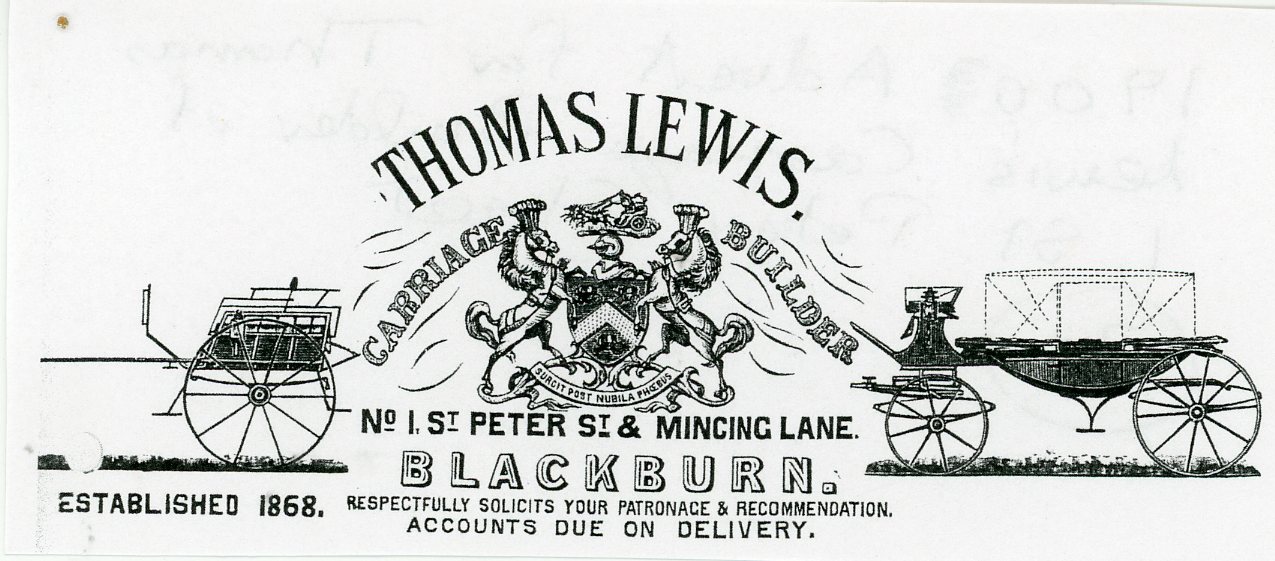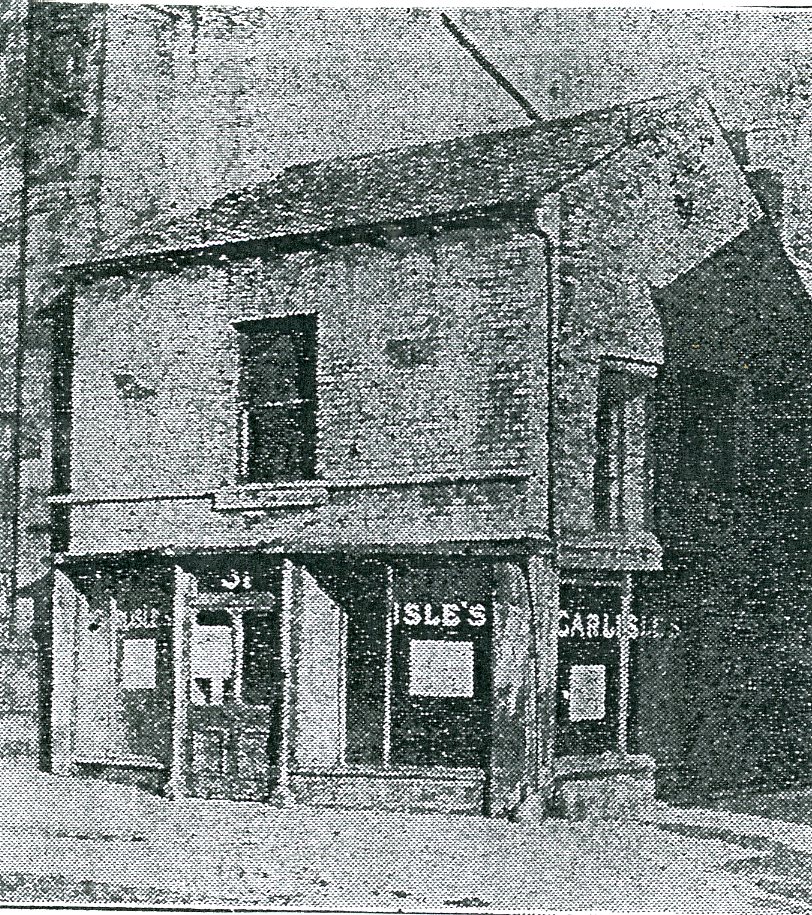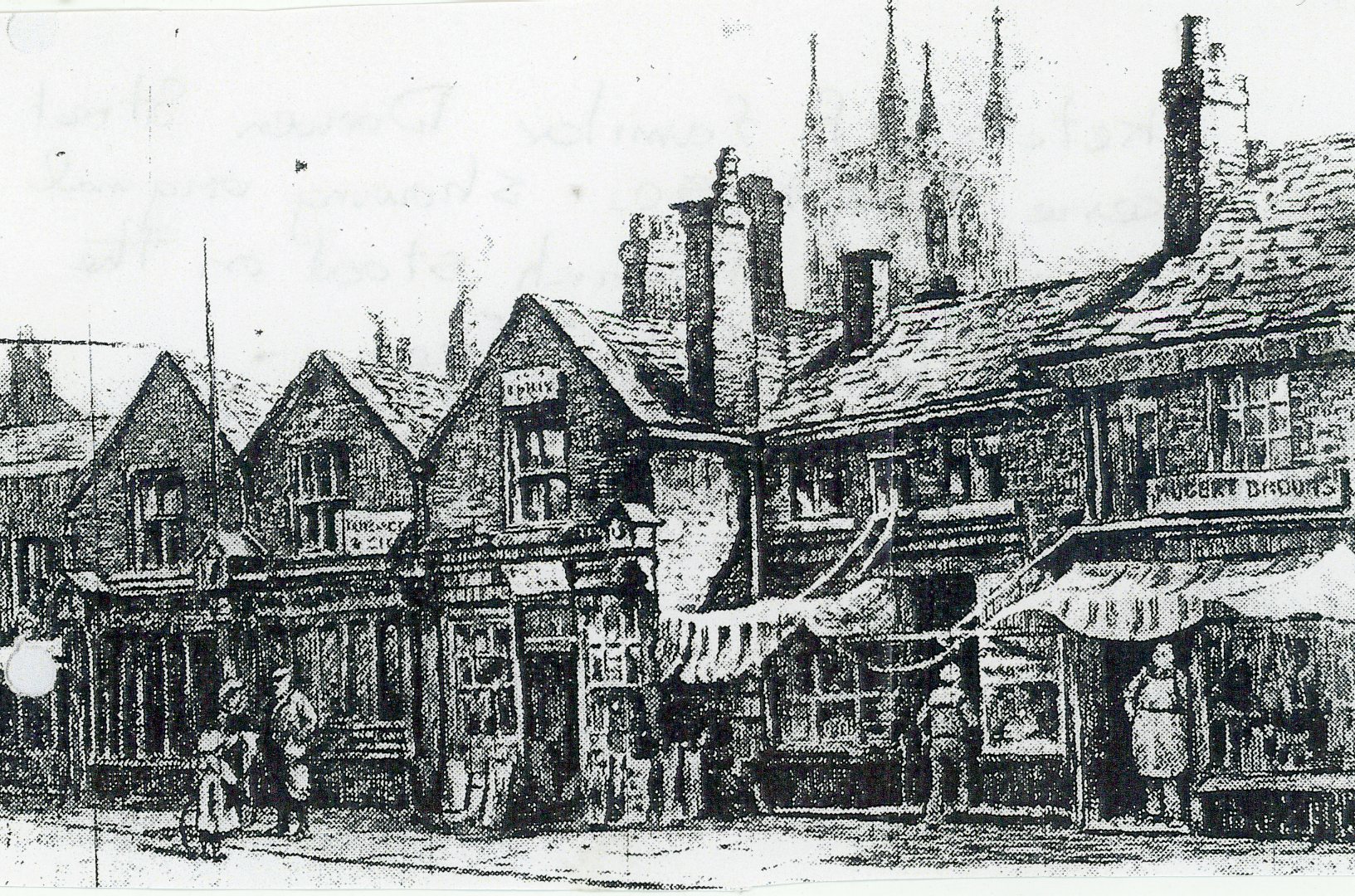DARWEN STREET SHOPS/BUSINESSES
Baines Directory of 1824 shows the following tradesmen in Darwen Street and it will be noticed that the shops etc. are numbered consecutively and not as now with odd numbers on one side of the street and evens on the other:
OLD BULL INN (Posting House for mails)
1. John Kay – Butcher and deputy police constable.
1a Charles Holland – Hat Manufacturer
2. Richard Horner – Cooper
3. John Watson – Watchmaker
4. Daniel and John Dewhurst – Bakers and Confectioners.
5. John Beech – Landlord of the Legs of Man.
6. John Thwaite – Chemist and Druggist.
7. Hargrave Wraith – Chemist and Druggist.
8. John Haworth – Landlord of Bird- in- Hand.
9. Thomas Sharples – Gardener
Edward Horseman – Cheesemonger.
10. Ralph Marsden – Landlord of the Queens Head.
11. John Myers – Saddler.
12. John Polding – Grocer, Corn and Flour dealer.
13. John Clark – Grocer, Corn and Flour dealer.
14. Robert Carter – Saddler.
15. Elizabeth Gill – Butcher.
16. Thomas Ainsworth – Farrier.
17. Joseph Pomfret – Brushmaker.
John Whewell – Brushmaker.
19. William Bradley - Baker and Shuttlemaker.
21. Hugh Gregory – Umbrella maker.
22. John Kenyon – Clogger.
23. William Holden – Landlord of the White Bull.
25. Richard Pilkington – Joiner and Timber Merchant.
29. Thomas Wensley – Blacksmith.
30. William Wilson – Ropemaker.
32. Thomas Sagar – Shopkeeper.
33. Thomas Duxbury – Baker.
34. John Gill – Butcher.
35. Thomas Feilden – Clogger.
36. John Farrer – Tallow Chandler.
37. Elizabeth Williams – Straw Hat Manufacturer.
37. William Williams – Wood Turner.
38. Elizabeth Eckroyd – Shoemaker.
39. James Abbott – Shoemaker.
40. Bridget Howard – Milliner.
42. James Caughey – Shopkeeper.
44. Philip Lancaster – Ladies Bootmaker.
45. Thomas Hatch – Dyer.
46. James Graham – Butcher.
47. Matthew Dean – Nail Maker.
47. William Walkden – Dyer.
47a Jonathan Wright – plumber.
48. Thomas Sellers – Butcher.
49. T. & J. Stones – Joiners and Cabinet Makers.
50. John Harrison – Shoemaker.
51. Thomas Holden – Landlord of the Duke of York.
52. Richard Pilkington – Householder.
53. Mary King – Milliner.
53. Benjamin King – Attorney.
56. Henry Leigh – Grocer.
57. Ralph Waddington – Clogger.
58. Robert Byrom – Clothier.
59. Edmund Mullineax – Blacksmith and Shopkeeper.
60. Peter Longworth – Blue Dyer.
60. William Grimshaw – Nailmaker.
61. Mary Ainsworth – Milliner.
62. Henry Dean – Landlord of the Hare and Hounds.
63. James Bradshaw – Joiner and Cabinet Maker.
64. Thomas Haworth – Landlord of the Ship Inn.
65. Thomas Howarth – Clogger.
66. Jane Harrison – Eating House.
67. Joshua Goldsboro – Tailor.
68. John Sharples – Shoemaker.
71. John Gibson – Cooper.
72. James Wilkinson – Shoemaker and Currier.
74. Barnhill – Tailor.
79. Mary Taylor – Milliner.
80. John Thompson – Corn and Flour dealer.
81. James Bradshaw – Rag Merchant.
82. William Bury – Shopkeeper.
83. Edmund Holden – Landlord of the Three Crowns.
84. John Kitchen – Butcher.
86. James Broadly – Landlord of the Anchor Inn.
87. Margaret Brown – Confectioner.
88. Richard Robinson – Saddler.
89. Henry Whittaker – Landlord of the Wheat Sheaf
Wheat Sheaf Yard – Richard Cunliffe – Baker, William Parker – Blacksmith
John Todd – Wheelwright.
90. Joseph King – Shoemaker.
91. McGhie and Knox – Grocers and Drapers.
92. Thomas Turner – Residence (Calico Printer).
93. John Threlfall – Ironmonger.
94. Robert Briggs – Glass and China Dealer.
95/96 Henry Copeland – Grocer, Wine and Spirit Merchant.
97. William Blackburn – Corn and Flour Dealer.
98. Ralph Booth – Landlord of the Eagle and Child.
99. John Briggs – Butcher.
100. William Callis – Grocer.
101. John Middlehurst – Grocer and Flour Dealer.
102. Richard Walker Grocer and Corn/Flour dealer.
103. Foster and Smithson – Grocers.
104. Ralph Knight Marsden – Hat and Shoe Warehouse.
105. John Foster – Bacon factor, Grocer.
106. Roger Wood – Printer, Newsagent, Tea Dealer, Library.
106a. William Butterfield – Fruiterer.
 Original sketch of shops fronting the Cathedral Grounds in 1850.
Original sketch of shops fronting the Cathedral Grounds in 1850. John Polding’s Corn Merchants Shop opposite St. Peter Street in 1890s.
John Polding’s Corn Merchants Shop opposite St. Peter Street in 1890s.
OTHERS IN DARWEN STREET AREA
Jane Durham – Ladies Day School – Turner’s Court.
Robert Turner and sons – Calico Manufacturers.
Bannister Eccles and Co. – Cotton Spinners and Manufacturers – Jubilee Mill.
Reverend John W. Whittaker – Vicarage - Darwen Street.
Dorothy Carter – Milliner – Churchyard.
PLACES OF INTEREST OFF DARWEN STREET
1. FLEMING SQUARE – The land and buildings in this square were bought in 1816 by Merchant and Broker, John Fleming, from whom the square is now named. It appears that originally the present access onto Darwen Street didn’t exist as it was covered by a huge Mansion House that faced the town’s market place, stretching from Higher Church Street down towards Market Street Lane. Behind this mansion was a public house called the New Black Bull which could explain why the square before Fleming bought it was called New Square. Fleming built the Exchange Arcade, the town’s first shopping arcade whose buildings are still present having been restored. Prior to its erection, the site was occupied by shop premises that included a Whitesmiths, Reed maker for weaving looms and Stables. In 1823, Fleming built the Cloth Hall on the side of the square which was intended for the sale of woollens but most of the premises were soon occupied by 22 butchers to take advantage of the proximity of a slaughter-house in the square. However, when the market moved most of them moved with it. On the Back Lane (Mincing Lane) side of the square was a large barn and stables but, by 1856, it had been demolished for new premises which also had a colonnade like the cloth hall. The Exchange Arcade has a date stone for 1849 above what was originally the entrance into the inner units and, it was in that year, George Hopwood, a former handloom weaver turned the premises into a slipper and steam baths which continued into the next century and had two tall brick chimneys. It is thought the Hot Air Baths were Russian baths which had stone cubicles lit by skylights. During the 1950s this area became run down but, in 2001, the area and the Exchange were part of a restoration and renovation project.

Fleming square and the Exchange Arcade with the
original chimneys of Hopwood’s Hot Air Baths.

Hopwood’s Baths old enamel sign discovered during later
renovations in the Exchange Arcade.
2. MR. ROBERT JEPSON – 12, Fleming Square – commenced business in 1890 supplying the trade with all kinds of better-class paper-hangings including Lincrusta, Japanese, Leather, Anaglypta and Salamander papers. He also dealt in paints, varnishes brushes and many other items used by the painting and decorating trades. His premises consisted of a shop and office and three upper floors and a basement to house his stock. The family of Jepson’s later moved into household furniture and furnishings and operated from Nova Scotia Mill off Bolton Road.
3. MARKET STREET LANE – This narrow-cobbled lane connected Darwen Street to Back Lane (Mincing Lane) taking its name from the fact it led from the busy market on Darwen Street therefore it had many old buildings, including warehouses and hostelries, to make use of the market’s location. One of its main features was the ancient Blackburn hostelry known as THE CASTLE INN one of Blackburn’s oldest inns as it can be traced back to the 1790s when the first known landlord was Mr. Gornall. During the loom riots of 1808, 145 of the town’s main townsmen were sworn in as “assistant constables” at three main hostelries including "The Castle" where 49 special constables were sworn in, including its landlord Mr. T. Scott. During 1810, the Inn was re-built with extensive alterations offering a Travelers Room and a new central staircase giving easy access to the new bedrooms and private rooms. At the same time, the extensive Stabling and Coach Houses were completely repaired, these catered for Post Horses and Chaises. Like all the houses of its period erected in the older central streets of Blackburn, the Castle Inn was built of red brick. All the restoration work on the inn was carried out by Mr. J. Cronshaw of Montague Street from designs by the architect Mr. J.H. Sandbach of Richmond Terrace for its owner Mr. John Crook of Spring Vale Darwen. As with other local inns on or close to Darwen Street it benefitted from being near the original market on Darwen Street.
The main feature of the inn were the two semi-circular bays carried up in three storeys to the full height of the roof, designed to give the building a castellated appearance in keeping with its name. During the period prior to the development of the Central Conservative Club, the Castle Inn was one of the main inns frequented by the Conservative Party for meetings and looked upon as a headquarters for the party. In 1826, the new landlord, Mr. Robert Graham, advertised the fact that a London daily and various provincial papers were received regularly, which was a great inducement to its patrons as the papers at that time were expensive, so only the more affluent could afford them. In 1859, the landlord was James Riding better known to his locals as “Cock Robin” as he was the first driver of the “Highflyer Coach” which started from the nearby Dun Horse and ran to Manchester.
 Castle Hotel in 1894 on Market Street Lane.
Castle Hotel in 1894 on Market Street Lane.
Another ancient hostelry on the lane was THE DUN HORSE INN on the corner of Market Street Lane and Mincing Lane. Originally, the Dunn Horse was located further back in the lane, closer to Darwen Street and its market, almost opposite the Castle Inn. It moved in 1873 to its present location when the Darwen street market moved; its older location could be traced back to the 1770s when it was sold with a mansion house, cottages, barn and land in the Beardwood area of Blackburn. Like the Castle Inn, it ran coaches and post carriages. The pictorial sign of the Inn was a dun coloured horse in keeping with its name. The Inn had accommodation for travellers and could provide Post Chaises with careful drivers, Gigs and excellent saddle horses at short notice, according to an advert of the early 1800s. Being a posting-house, as opposed to a coaching inn, meant it was devoted to private travellers so it kept relays of horses ridden by postillions or a post-chaise or two. This meant a traveller could be taken in his own carriage or a hired chaise to any destination, often used by the landed gentry, postilions and other important personages. Riding Post soon became known for travelling at breakneck speeds and urgent letters were endorsed “Post Haste” but were also responsible for some spectacular crashes. In 1824, a carrier’s waggon left the Dun Horse yard for Preston and Kirkham every Tuesday morning at 11am whilst others left daily for Manchester and Chorley.
4. THE OLD ASSEMBLY ROOM– was situated on the opposite corner of Market Street Lane and Mincing Lane to the present location of the Dun Horse Inn. It was originally the venue of Blackburn’s gentry when it flourished in the 1790s; it was built in 1787 and was called the New Assembly-Room, a title later used by the premises on Heaton Street. It comprised of a large well-lit room on the second floor but the building saw many changes over the years. During one period, it was used as a Grammar School (before the erection of the school on Freckleton Street) then it became a Mechanics Institute, and later, it was used by the Temperance Society. In 1851, it was converted into a Music Hall later called Papa Pages Lyceum. It is recorded that the first week of Mr. Page's reign at the Lyceum was celebrated by a visit from the Royal English Opera Company and subsequently many famous artists of the day followed, including comedians such as Harry Whaling who had the audacity to poke fun at the audience, a brave thing to do when Lyceum audiences were known to give artist “the bird”. Not all artists were male and perhaps the most famous artiste to ever visit The Lyceum was Vesta Tilley who once played a week there when approaching stardom. One of the greatest names in show business was that of George Formby but there were two of them, namely father and his famous son. The father, born in 1880, was originally a blacksmith’s striker in Ashton-under-Lyne but the work was too heavy for him and his only solace was to sing comic ditties and strum on an old banjo in his spare time until he was spotted and signed up as an artiste and later appeared at the Lyceum. The Lyceum orchestra consisted of a pianist who was Mr. Page and a violinist. The Lyceum finally closed in April 1902.The ground floor of the building was owned by J. Haworth of the Borough Wire works from 1887 and, from 1902, by A. Duckworth till 1966 when the owner was G Martin Ltd and run as a Hardware Shop.

The Old Assembly Room on the corner of Market Street Lane and Mincing Lane,
Later the Borough Wire Works from 1887, then a hardware shop in more recent times.
5. ST. PETER STREET – This was established after 1848 when property on Darwen Street was demolished and Brogdens Yard used to create the street connecting Darwen street to Back lane (Mincing Lane).
THOMAS LEWIS – established his carriage building business at No 1 Peter Street in 1868 on the corner with Mincing Lane. In 1875, he was joined, as a partner, by his brother-in-law, John Lewis, creating T. & J. Lewis until 1885, when the partnership was dissolved. The works of the firm occupied a handsome showroom, body- making room, trimming room, paint room and a large smithy and, by 1900, was using steam power to operate machinery for the business. There was also a spacious yard and outhouses. Every type of vehicle was created at the works including broughams, landaus, wagonettes, phaetons and dogcarts. Mr. Lewis also did a large trade in repairs and employed a large staff for the business. Apart from a large proportion of the business being for the gentry and tradesmen of Blackburn, business connections reached all over Lancashire, Yorkshire and Cheshire. Later in the 1900s, the business was taken over by J. E. Farr, a motor coach builder who advertised that Farr’s bodies make the most of any chassis. The firm also produced Cape Hoods, Wind Screens and side cars for motor cycles and van bodies for commercial vehicles. The cousin of Thomas Lewis who went on to marry him, namely Mrs. Elizabeth Lewis, was known as Blackburn’s Temperance Queen or the “Drunkard’s Friend”. Mrs Lewis waged a life-long battle against drink, starting in 1882, when the town had 604 licensed premises and a reputation of being the beeriest town in England. She ran her campaign at the Lees Hall Mission in Mincing Lane now the Headquarters of the town’s St. John Ambulance. At outdoor meetings she persuaded thousands to sign the pledge and became a local personality having anthems dedicated to her and her movement.

1900 Advert for Thomas Lewis Carriage Builder of 1, St. Peter Street.

Picture of Mrs. Lewis on her travels in one of her husband’s carriages
whilst lecturing on the folly of drinking alcohol,
with the horse carrying a sign “We Drink Water.”

1915 advert for J.E. Farr Motor Coach Builder
who took over Mr. Lewis’s premises.
OLYMPIA – was another well-known Town landmark on St. Peter Street which first opened in 1909 as the Olympia Roller Skating Rink on the site of Thomas Lewis’s old livery stables. The Olympia was one of four opened in just four months in Blackburn to meet the new craze. The boom only lasted two years and the Olympia then became a Concert Hall and Theatre. After this, it became the Olympia Cinema, one of fourteen Blackburn had at its picture-going peak. By 1958, however, it was transformed into the swish Locarno Ballroom which opened in 1959 and catered for up to 1000 people a night. As a result, it became the top dancing spot in East Lancashire boasting two resident bands, a revolving stage, a “Cupids Corner” with a two-tier bar, the Pony Tail milk bar and the plush Viceroy Bar. Many well- known pop stars of the day appeared at the ballroom and Monday Rock ‘n’ Roll nights were hugely popular when teenagers paid 1s 6d to dance to records. Its holding company Mecca then gave it a £30,000 facelift in 1969 and turned it into the Golden Palms nightspot with the dance hall being given a night-club atmosphere. This venture later gave way to Bingo in 1981 when it became the Mecca Social Club. In more recent times it has again been transformed into a night-club under various names including Liquid Envy to keep pace with modern trends.

Olympia Cinema on St Peter Street developed after the Roller Skating in the 1950s.
It last showed films in 1958 and later became the Mecca Ballroom.

Interior view of the Olympic Roller-skating Rink in early 1910 on St. Peter Street.
The WHEATSHEAF HOTEL – on the opposite corner of St. Peter Street and Mincing Lane to Tom Lewis’s premises was an ancient hostelry first sited on Darwen Street (see earlier text) before transferring to this site after the market left Darwen Street. The rear of the hotel was used as a livery stable. This Victorian hostelry is at present closed.

The Victorian Wheatsheaf hotel on the corner of
St Peter Street and Mincing Lane early 1900s.
The NEW WESLEYAN SCHOOL– was built further along St. Peter Street which opened in 1862 at a cost of £1800. It provided school places for boys, girls and infants during the week and became a Sunday school on the Sabbath and had a separate house alongside it for the schoolmaster. Later, during the wartime rationing era it became the local Food Control Offices and, more recently, became used as a glass-works.

The New Wesleyan School on St. Peter Street in 1890.
THE OLD BEDDING SHOP – this was an old, interesting building that ended up attached to the lower end of the General Post 0ffice on Darwen Street and was demolished in 1923 when the Post office was extended. The building formed an interesting link with Blackburn’s past. The little building had been a bedding shop for 65 years and was run by Messrs. Carlisle’s for the last 16 years prior to demolition. Going back in history it was a plumber’s shop and, before that, a brush maker’s, and its history takes it back to Blackburn’s early business times. It had massive walls from two to three feet in thickness and stone buttresses supporting the roof with old oak beams one foot in diameter indicating its age probably 16th or 17th century. There is speculation that it could originally have been a farm as indicated by its interior roof construction.

The ancient Old Bedding Shop Darwen Street 1923
demolished when the General Post Office was extended.
TYPICAL FRONTAGE OF OLD DARWEN STREET SHOPS

Sketch of a familiar Darwen Street scene from 1850s, showing original
shops some of which stood on the later site of the Post Office.

Early 1900s view of Lower Darwen Street with original shops on the right,
the later site of Edmondson’s house furnishers.

View of Darwen Street from its junction with Jubilee Street with the Central Mission Hall in the background.
OLD BILL HEADS FOR DARWEN STREET BUSINESS PREMISES

C. Cheatham, Registered plumber, gasfitter and glazier,
47 and 49 Darwen Street.
Robert Howson, Cycle dealer and repairer, 68, Darwen Street.

Richard Cross, Cabinet Maker and Upholsterer, 70, Darwen Street.

Charles Knowles, Printer, Bookbinder, Stationer and supplier of fountain pens,
72, Darwen Street.
E. Findlay, Wholesale Pork Butcher, 92, Darwen Street.
 Daniel Yates, Wholesale Druggist and Drysalter, Oil and Colourman, Darwen Street.
Daniel Yates, Wholesale Druggist and Drysalter, Oil and Colourman, Darwen Street.
William Stones and Sons, Builders and Timber Merchant, Darwen Street Mills.

